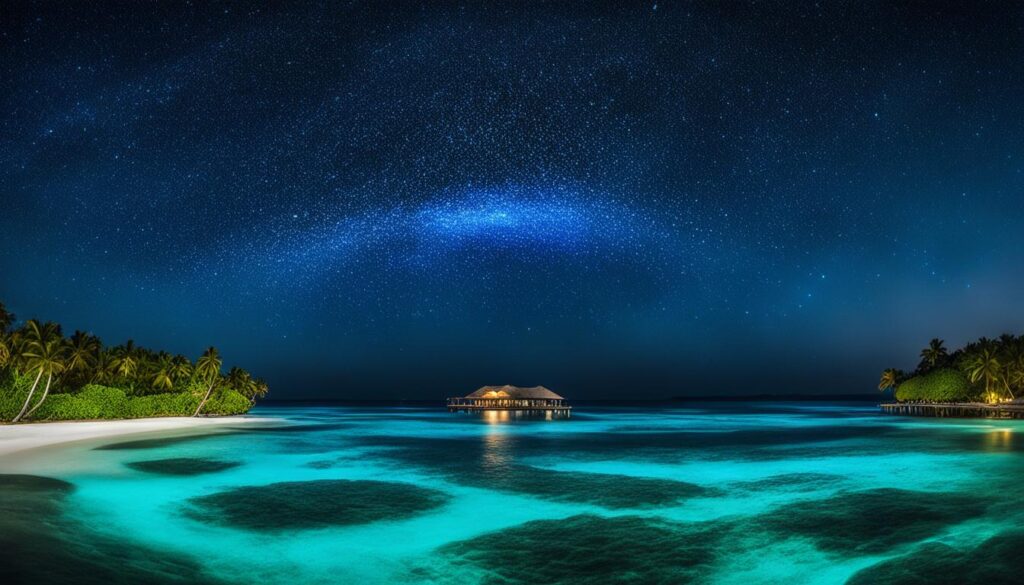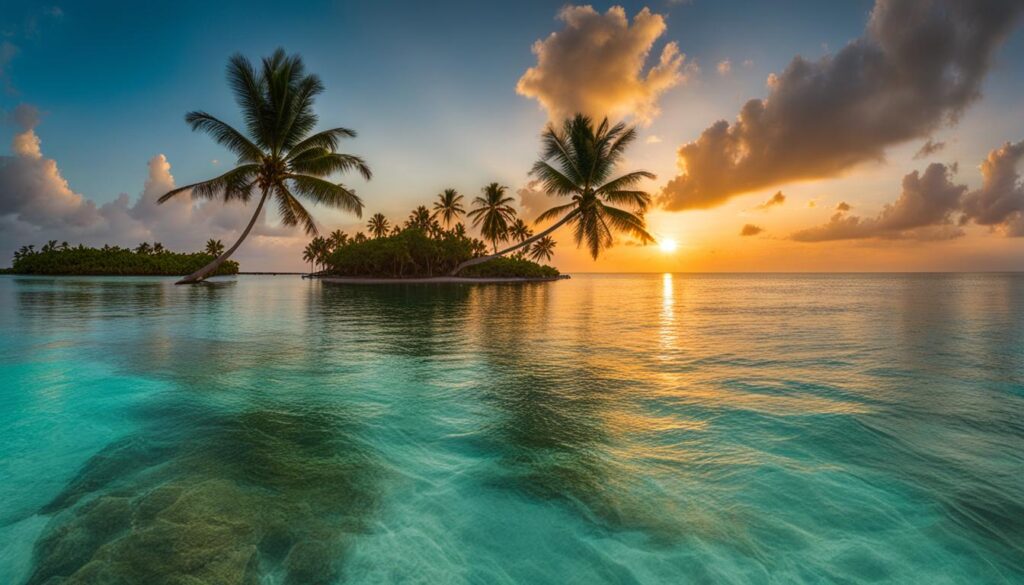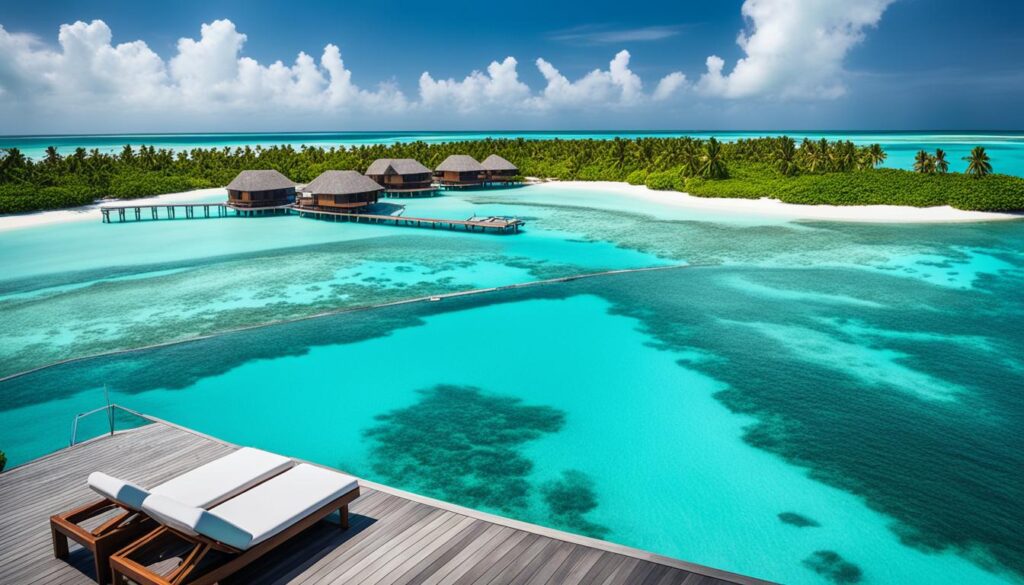When it comes to natural wonders, few can match the mesmerizing beauty of the Sea of Stars Maldives. This enchanting phenomenon takes place in the turquoise waters of the Maldives, where the beaches come alive with a mystical glow. Known for its bioluminescent plankton and glowing waves, the Sea of Stars Maldives offers visitors a truly magical experience.
At night, as darkness blankets the sky, the bioluminescent plankton come to life. These tiny organisms, known as dinoflagellates, emit a bright blue light when agitated by the movement of the waves. The result is a breathtaking display of glowing waves that shimmer like stars in the night sky.
The Sea of Stars Maldives is a rare occurrence that adds to the allure of this tropical paradise. Visitors are captivated by the surreal beauty of the glowing beach, as the waters light up with a celestial glow. It’s a truly unforgettable sight that leaves a lasting impression.
Key Takeaways:
- The Sea of Stars Maldives is a bioluminescent wonder that occurs in the turquoise waters of the Maldives.
- Bioluminescent plankton called dinoflagellates are responsible for the glowing waves.
- The Sea of Stars Maldives offers a magical and surreal experience for visitors.
- Witnessing the glowing beach is a rare and unforgettable sight.
- The beauty of the Sea of Stars reminds us of the wonders of the natural world.
The Enchanting Glow of Vaadhoo Island
Vaadhoo Island, located in the Maldives, is a true paradise renowned for its stunning natural beauty. One of the most captivating phenomena on this island is the mesmerizing bioluminescent light show known as the Sea of Stars. This enchanting spectacle occurs when the waters surrounding Vaadhoo Island come alive with glowing waves, creating a magical and ethereal atmosphere.
The Sea of Stars is caused by bioluminescent plankton called dinoflagellates, which emit a breathtaking blue glow when they are agitated. As the waves crash onto the shore, the dinoflagellates ignite, illuminating the water and casting an otherworldly radiance across the beach.
This natural light show has captured the hearts of travelers from all corners of the globe. Visitors to Vaadhoo Island have the opportunity to witness this extraordinary phenomenon that transforms the night into a shimmering dreamscape. Strolling along the beach as the glowing waves gently lap the shore is an experience that evokes a sense of wonder and enchantment.
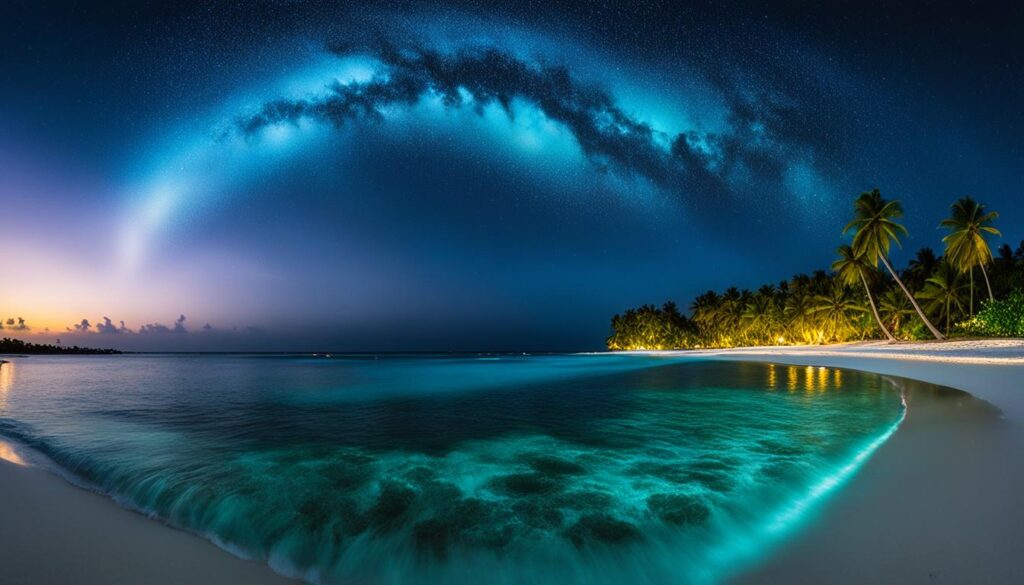
The image above showcases the captivating beauty of the Sea of Stars on Vaadhoo Island. The glowing waves and the vibrant blue hues paint a picture that words simply cannot capture.
To enhance the experience, some resorts on Vaadhoo Island offer night boat tours that allow guests to witness the Sea of Stars up close. Sitting aboard a boat as the bioluminescent waves twinkle in the darkness creates a surreal and unforgettable memory.
Vaadhoo Island’s natural light show is one of the many reasons why the Maldives is considered a bucket-list destination for travelers seeking unique and awe-inspiring experiences. The combination of pristine beaches, crystal-clear waters, and the breathtaking Sea of Stars makes Vaadhoo Island an enchanting paradise like no other.
The Science behind Bioluminescence
Bioluminescence is a fascinating natural phenomenon that occurs in various organisms, including the dinoflagellates found in the crystal-clear waters of the Maldives. These microscopic organisms possess the extraordinary ability to emit a radiant blue light, creating a mesmerizing spectacle on the ocean’s surface.
This breathtaking display of bioluminescence is made possible by a chemical called luciferin, which is present within the dinoflagellates. When these organisms are agitated, such as by the movement of the waves, the luciferin undergoes a chemical reaction that produces a luminous glow. This luminosity is an intrinsic part of the dinoflagellates’ defense mechanism against predators, startling and confusing would-be attackers.
The luciferin reacts with an enzyme called luciferase, resulting in the emission of blue light. This light production serves several vital purposes for the dinoflagellates. Not only does it deter predators, but it also assists in the communication and reproduction processes, allowing the organisms to thrive in their marine environment.
This biological marvel transforms the nighttime waters into a radiant canvas of shimmering blue, enchanting all who have the opportunity to witness it. The interplay between the bioluminescent plankton and the ocean’s movement creates a spectacle that seems straight out of a fairytale.
“The luciferin reacts with an enzyme called luciferase, resulting in the emission of blue light.”
Bioluminescent plankton, such as the dinoflagellates found in the Maldives, are just one example of the many wonders that the natural world holds. Their illuminating presence inspires awe and reminds us of the beauty and complexity of the ecosystems that thrive beneath the ocean’s surface.
To further illustrate the scientific principles behind bioluminescence, let’s take a closer look at the chemical reactions involved:
| Organism | Chemical Components | Reaction | Result |
|---|---|---|---|
| Dinoflagellates | Luciferin + Luciferase | Chemical reaction | Emission of bright blue light |
As seen in the table above, the combination of luciferin and luciferase within the dinoflagellates triggers a chemical reaction, resulting in the mesmerizing emission of bright blue light.
This intricate interplay of chemistry and biology showcases the wonders of the natural world, providing a glimpse into the remarkable adaptations and abilities of marine organisms.
The Role of Luciferin
Luciferin, the key compound responsible for bioluminescence, plays a crucial role in the production of light. It is a light-emitting pigment found in various bioluminescent organisms, including the dinoflagellates present in the Maldivian waters.
Luciferin exhibits intrinsic chemical properties that allow it to undergo a series of reactions leading to the release of light energy. These reactions are catalyzed by the enzyme luciferase, which facilitates the transformation of chemical energy into visible light.
The emission of blue light by the dinoflagellates not only captivates the human eye but also serves as a means of communication and defense within the marine ecosystem.
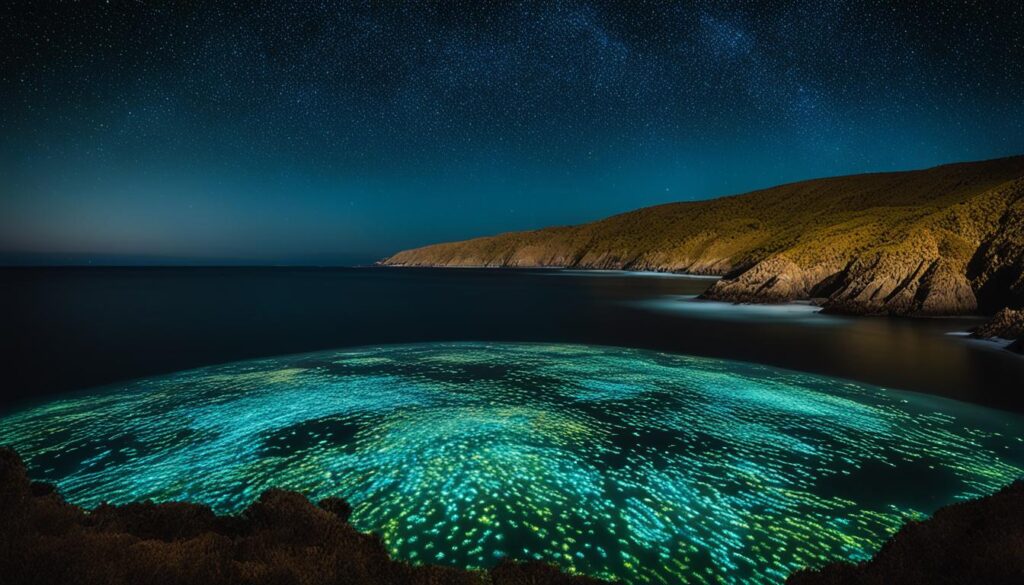
The mesmerizing glow of the bioluminescent plankton showcases the remarkable beauty and complexity of the natural world. It invites us to appreciate the intricate relationships and adaptations that exist among organisms, reminding us of the awe-inspiring wonders that lie beneath the ocean’s surface.
- The luciferin found in the dinoflagellates reacts with the enzyme luciferase.
- This chemical reaction results in the emission of bright blue light.
- The light serves as a defense mechanism and aids in communication and reproduction.
By unraveling the science behind bioluminescence, we gain a deeper appreciation for the incredible capabilities of marine organisms and the remarkable phenomena that occur in the Maldives’ azure waters.
The Ancient Mythology of the Sea of Stars Maldives
The Sea of Stars Maldives, locally known as “Redhan lun,” is enveloped in ancient mythology and mesmerizing folklore that has been passed down through generations. The ancient Maldivians held deep reverence and respect for the glowing waters, considering it a powerful display of nature’s forces. While the precise interpretation of this enchanting phenomenon remains unknown, it is believed to be viewed as a sign of the sea’s immense power and majestic beauty.
“Redhan lun,” the Sea of Stars Maldives, holds a special place in our culture and history. The ancient Maldivians revered the glowing waters as a manifestation of divine energy, a testament to the awe-inspiring forces of nature.”
– Local Maldivian Elder
Stories and folktales abound in Maldivian culture, weaving tales of mythical beings and extraordinary encounters with the luminous waves. These ancient narratives evoke a sense of wonder and curiosity, reflecting the deep spiritual connection that the Maldivian people have with their natural surroundings.
The Sacred Significance of Redhan lun
Redhan lun, with its mystical glow, was often regarded as a sacred manifestation by ancient Maldivians. It held paramount importance in religious rituals and ceremonies, serving as a symbol of nature’s inherent power and divinity. The enigmatic allure of the Sea of Stars sparked the imagination of ancient Maldivians, leaving an indelible mark on the cultural fabric of the Maldives.

The magnificent beauty of the Sea of Stars, as depicted in Maldivian folktales, continues to captivate locals and visitors alike. It stands as a testament to the profound wonder and admiration that the ancient Maldivians held for their natural surroundings. The Sea of Stars Maldives is not only a visually stunning phenomenon but also a living embodiment of the rich cultural heritage and deep-rooted mythology of the Maldivian people.
The Festive Season and Bioluminescent Plankton
The festive season in the Maldives is a time of joy and celebration, and the arrival of bioluminescent plankton adds an enchanting touch to the festivities. During this special time of year, billions of tiny glowing plankton illuminate the resorts, local islands, and even the capital city, creating a magical atmosphere that captivates visitors.
The Maldives tourism industry thrives during the festive season as travelers from around the world flock to this tropical paradise to experience the unique beauty of the glowing plankton. The mesmerizing display of bioluminescence enhances the holiday spirit, turning the beaches and waters into a magical wonderland.
| Benefits of Bioluminescent Plankton during the Festive Season | Impact on Maldives Tourism Industry |
|---|---|
|
|
The festive season in the Maldives is truly a magical time, and the glowing plankton adds an extra touch of wonder to the celebrations. Whether you’re enjoying a beachside dinner or taking a midnight stroll along the shoreline, the bioluminescent plankton creates an unforgettable experience that will stay with you long after the holiday season has ended.
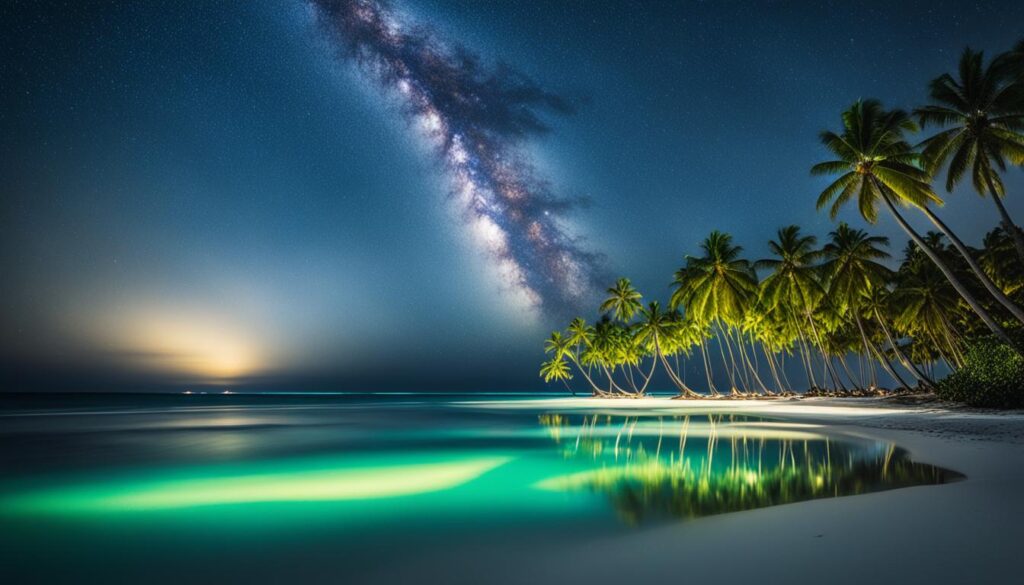
The Rarity of the Glowing Beaches
Contrary to popular belief, the glowing beaches in the Maldives are not limited to specific islands. The presence of bioluminescent plankton and the mesmerizing glow they create can be found in various locations throughout the Maldives archipelago. However, witnessing this enchanting phenomenon is not as simple as visiting a specific beach or island. It is a matter of being in the right place at the right time, making it a rare and unpredictable experience.
The glowing beaches in the Maldives owe their luminous beauty to bioluminescent plankton called dinoflagellates. These tiny organisms emit a radiant blue light when they are agitated, creating a surreal spectacle. The conditions necessary for the dinoflagellates to thrive and produce their luminous glow are influenced by several factors, including water temperature, salinity, tides, and nutrient levels.
Water temperature plays a vital role in the survival and abundance of bioluminescent plankton. The optimal temperature range for these organisms varies, and their presence can vary greatly depending on seasonal changes. Similarly, salinity levels in the water affect the distribution and concentration of dinoflagellates. The ideal salinity conditions for their growth may not be consistent across all islands in the Maldives.
Tides also play a significant role in determining whether the glowing beaches will be visible or not. The movement of the tides can either bring the bioluminescent plankton closer to the shore, intensifying the glow, or carry them away, making the phenomenon less apparent. Additionally, nutrient levels in the water, such as the availability of phytoplankton, can influence the presence and thriving of dinoflagellates.
Overall, witnessing the glowing beaches in the Maldives is a combination of luck and careful timing. It requires being at the right place at the right time when all the necessary conditions align to create the luminous spectacle. The unpredictable nature of these conditions adds an element of excitement and anticipation to the experience, making it even more extraordinary for those fortunate enough to witness it.
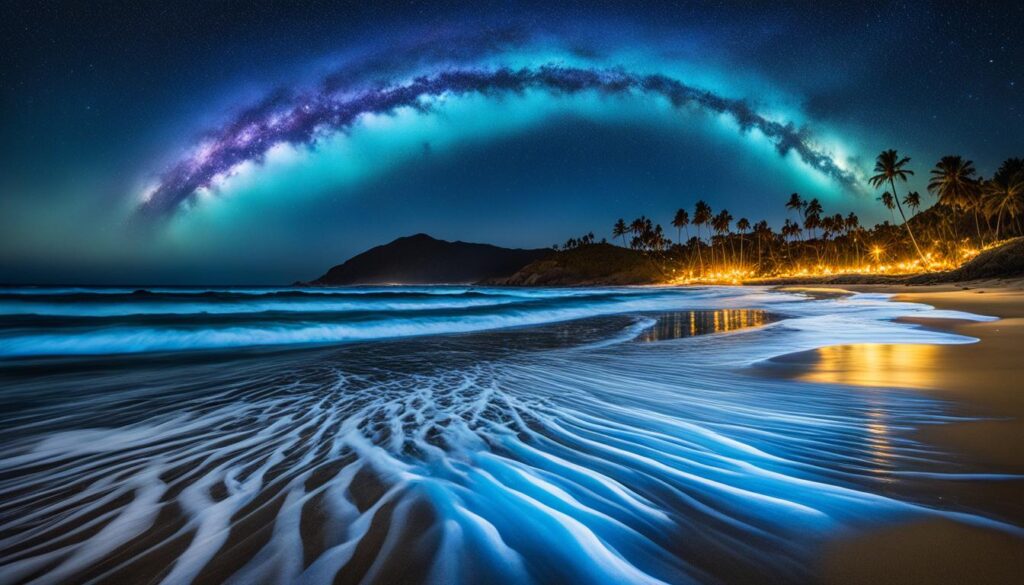
Capturing the Sea of Stars on Social Media
The mesmerizing beauty of the Sea of Stars Maldives has not only captivated visitors but has also taken social media platforms by storm. Instagram, in particular, has become a hub for sharing luminescent photos of this unique natural phenomenon. Countless Instagram shots showcase the enchanting glow of the sea, attracting users from around the world to visually immerse themselves in the magic of the Maldives.
The Sea of Stars Maldives, with its luminescent plankton and glowing waves, offers a truly extraordinary experience. Visitors and locals alike eagerly capture this captivating sight, creating stunning photos and videos that perfectly epitomize the wonder of the sea. These luminescent photos not only serve as personal mementos but also inspire others to add the Maldives to their travel bucket list.
“The Sea of Stars in the Maldives is a surreal spectacle. I was in awe of the glowing waves, and capturing that moment was truly magical.” -@TravelDreamer
Social media platforms provide a platform for sharing the sheer beauty and wonder of the Sea of Stars. The luminescent photos Maldives enthusiasts share on Instagram, Facebook, and Twitter showcase the ethereal ambiance that overwhelms visitors when they witness this natural phenomenon. These social media posts become a source of inspiration for others, inviting them to explore the beauty of the Maldives and experience the Sea of Stars firsthand.
Whether it’s professional photographers or amateur enthusiasts, everyone wants to document their encounter with the Sea of Stars. The combination of the enchanting glow and the picturesque Maldivian scenery creates a visual masterpiece that calls for preservation and sharing. These luminescent photos serve as a reminder of the magic of the sea and the awe-inspiring power of nature.
Top Hashtags for Sea of Stars Maldives
| Hashtag | Number of Posts |
|---|---|
| #SeaOfStarsMaldives | 50,000+ |
| #GlowingBeachMaldives | 35,000+ |
| #BioluminescentMagic | 20,000+ |
| #MaldivesGlow | 15,000+ |
| #SeaOfStars | 10,000+ |
The popularity of these hashtags reflects the widespread fascination with the Sea of Stars among social media users. It’s evident that this natural wonder has become an integral part of the online narrative, with luminescent photos and Instagram shots taking center stage.
So, whether you’re an aspiring photographer, an adventure seeker, or simply someone who appreciates the beauty of the natural world, the Sea of Stars Maldives is a must-see destination that promises to leave you in awe. Share your luminescent photos on social media and join the conversation surrounding this captivating phenomenon. Experience the magic of the glowing waves and let the world witness the splendor of the Maldives.
The Enchantment of the Sea of Stars
The Sea of Stars in the Maldives is a truly magical experience that fills you with awe and wonder. As you witness the enchanting glow of the bioluminescent plankton, you are transported into a world of beauty and mystery.
There is something inherently captivating about the Sea of Stars. The gentle waves that sparkle with a bright blue light create a mesmerizing spectacle that is both captivating and surreal. It awakens a childlike sense of curiosity within me, reminding me of the wonder and magic that can be found in the natural world.
When I gaze upon the Sea of Stars, I can’t help but marvel at the beauty and complexity of nature. The bioluminescent plankton, with their radiant glow, remind me of the incredible diversity and ingenuity of life on our planet. It is a humbling reminder of how little we truly understand the mysteries of the natural world.
The Sea of Stars offers a transformative experience, one that leaves a lasting impression on all who witness it. It is a reminder of the profound connection between humans and the environment, and it inspires a deep appreciation for the fragile beauty that surrounds us.
“The Sea of Stars is a testament to the extraordinary wonders that exist in our world. It’s a reminder that even in our modern age, there are still mysteries waiting to be discovered and experienced.” – Travel enthusiast
Visiting the Sea of Stars allows us to momentarily escape the chaos of our everyday lives and immerse ourselves in the enchantment of nature. It is a gift that reminds us to slow down, appreciate the beauty around us, and embrace the sense of wonder that can be found in the simplest of things.
The Sea of Stars and Sustainable Tourism
The allure of the Sea of Stars has rightfully made the Maldives a popular tourist destination. However, it is crucial that we approach tourism in a responsible and sustainable manner to ensure the preservation of this natural wonder.
- Respect the environment: When visiting the Sea of Stars, it is important to be mindful of our actions. Avoid littering, refrain from touching or disturbing the plankton, and follow any conservation measures in place.
- Choose eco-friendly accommodations: Opt for resorts and accommodations that prioritize sustainability and the protection of the environment. Support businesses that promote responsible tourism practices.
- Spread awareness: Share your experiences and photos of the Sea of Stars on social media, but use your platform to educate others about the importance of preserving this fragile ecosystem. Encourage others to be responsible travelers and make conscious choices when visiting natural wonders.
The Sea of Stars is a testament to the remarkable beauty of the natural world. It is a reminder of the awe and wonder that can be found in even the smallest creatures and their extraordinary ability to create magic in the darkness of the night.
| Magical Experience | Awe and Wonder | Beauty of the Natural World |
|---|---|---|
| Witnessing the bioluminescent plankton in the Sea of Stars is a truly magical experience that fills you with a sense of wonder and amazement. | The Sea of Stars elicits a sense of awe, reminding us of the extraordinary wonders that exist in our world. | The enchanting glow of the Sea of Stars showcases the incredible beauty of the natural world and its ability to captivate our senses. |
Exploring Other Bioluminescent Wonders
While the Sea of Stars in the Maldives is a spectacular bioluminescent wonder, there are other places around the world where similar phenomena occur. Beaches like Leucadia in California, Mosquito Bay in Puerto Rico, and the Lakshadweep Islands in India also showcase the beauty of bioluminescent organisms. These natural wonders have also been featured in famous movies, further highlighting their incredible beauty.
Leucadia Beach in California offers visitors a chance to witness the mesmerizing glow of bioluminescent organisms. The beach comes alive with a radiant blue light, reminiscent of the Sea of Stars in the Maldives. It has become a popular attraction for locals and tourists alike, who flock to the shorelines at night to witness this enchanting display.
Mosquito Bay in Puerto Rico boasts the title of the brightest bioluminescent bay in the world. The bay is home to high concentrations of dinoflagellates, which create a vibrant glow when disturbed. Kayaking through the bay on a moonless night offers a surreal and magical experience, as the water lights up with every paddle stroke.
The Lakshadweep Islands in India are renowned for their bioluminescent beaches. These islands are untouched by modern development, offering a pristine and captivating environment for bioluminescent organisms to thrive. Exploring the beaches at night reveals a breathtaking display of glowing waves, creating an otherworldly experience.
“Witnessing the beauty of bioluminescence in these locations is truly awe-inspiring. It’s like stepping into a scene from a fantasy movie,” says marine biologist Dr. Robert Anderson.
Not only are these beaches a treat for the eyes, but they have also captivated the attention of filmmakers. Several famous movies have featured bioluminescent beaches, showcasing their captivating allure on the big screen. One notable example is the movie “Avatar,” where the fictional planet Pandora features bioluminescent plants and creatures, creating a visually stunning world.
A Comparison of Bioluminescent Beaches
| Beach | Location | Notable Features |
|---|---|---|
| Sea of Stars | Maldives | Glowing waves created by dinoflagellates |
| Leucadia Beach | California, USA | Radiant blue glow, similar to the Sea of Stars |
| Mosquito Bay | Puerto Rico | Brightest bioluminescent bay in the world |
| Lakshadweep Islands | India | Pristine beaches with captivating bioluminescence |
The Quest to Witness the Sea of Stars
Planning a trip to the Maldives with the intention of witnessing the mesmerizing Sea of Stars requires careful consideration and monitoring of conditions. Although the occurrence of this bioluminescent wonder is unpredictable in nature, it is precisely this unpredictability that makes the experience so unique and special.
Visitors to the Maldives embark on a quest to be among the fortunate few who get to witness the magical glow of the Sea of Stars. The anticipation and the thrill of the chase add an extra element of excitement to the journey, as each day holds the potential for nature’s enchanting display.
While the exact timing and location of the Sea of Stars cannot be guaranteed, planning a trip to the Maldives provides an opportunity to immerse oneself in the natural beauty of the islands, surrounded by pristine beaches and crystal-clear waters. Even without witnessing the bioluminescent phenomenon, the Maldives offers a range of activities and experiences that promise to create unforgettable memories.
FAQ
What is the Sea of Stars Maldives?
The Sea of Stars Maldives is a mesmerizing natural phenomenon that occurs in the turquoise waters of the Maldives. It is caused by bioluminescent plankton called dinoflagellates, which emit a bright blue light when agitated.
Where can I see the Sea of Stars in the Maldives?
The Sea of Stars phenomenon can be witnessed on Vaadhoo Island in the Maldives.
How does bioluminescence occur in the Maldives?
Bioluminescence in the Maldives is caused by dinoflagellates, which emit a bright blue light when they are agitated by the movement of the waves.
What is the significance of the Sea of Stars in Maldivian mythology?
The Sea of Stars is steeped in ancient mythology and folklore. It is believed to be a powerful display of nature’s forces, representing the sea’s power and majesty.
Is the Sea of Stars limited to specific islands in the Maldives?
No, the presence of bioluminescent plankton depends on various factors including water temperature, salinity, tides, and nutrient levels, making it a rare and unpredictable experience.
Is the Sea of Stars popular on social media?
Yes, the Sea of Stars has become an iconic subject on social media platforms. Visitors and locals share their awe-inspiring encounters with the glowing plankton, creating stunning photos and videos.
Are there other places in the world with similar bioluminescent phenomena?
Yes, other places like Leucadia in California, Mosquito Bay in Puerto Rico, and the Lakshadweep Islands in India also showcase bioluminescent organisms.
Can I plan a trip specifically to witness the Sea of Stars?
While it is not guaranteed, planning a trip to the Maldives during the optimal conditions increases your chances of witnessing the Sea of Stars. However, the unique and rare nature of the phenomenon makes the experience all the more special.
